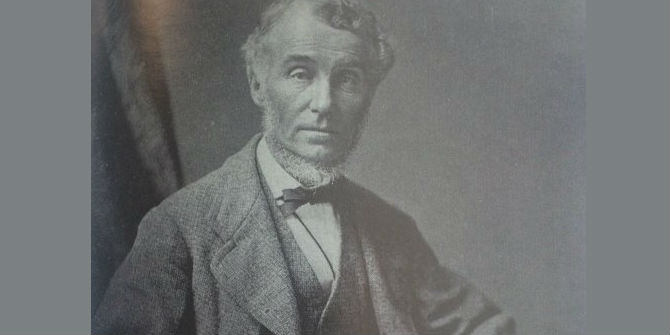LSE’s History series for LSE Women: making history celebrates some of the notable women at LSE through the years. Sue Donnelly looks back at Ellen Marianne Leonard: first woman President of the LSE Students’ Union.
In 1907 the LSE Students’ Union elected its first woman President, also known as the Chairman of the Common Rooms Committee. Ellen Marianne Leonard (1866-1953) was a 41 year old historian who had been connected to LSE since 1896. However writing about Ellen’s life has illustrated the difficulties of tracing the careers of women academics.
Fortunately Ellen was one of the Girton students who made their way to LSE and information on her background can be found in the Girton Register. Ellen was born on 4 September 1866 in Clifton, Bristol. Her father was John Hare Leonard (1823-1893) and her mother Ellen, née Perrin. In 1872 Ellen’s father formed a partnership with George Bligh Capel and Eugene Carless in running and developing the Hope Chemical Works in Hackney Wick distilling American crude oil and refining coal tar. In time Carless, Capel and Leonard were to be leading producers and distributors of motor launch spirit – petrol. In 1896 the company, then managed by Ellen’s brother, provided the fuel for the Emancipation Run from London to Brighton –the fore runner of the London to Brighton Car Rally.
Ellen was the youngest child in the family and the only daughter. She made her way to LSE via several academic institutions. According to the Girton Register she spent three years at University College, Bristol before gaining a Courtauld Scholarship for Study in Arts at Bedford College, London. In 1885 she was awarded a certificate of merit in English Literature and in the same year she started at Girton College, Cambridge obtaining a first class in the History Tripos in 1888.

We can infer that women’s education was valued her family, particularly her mother’s family the Perrins, as Ellen was joined at Girton by her cousin Emily Perrin Story studying mathematics who became a teacher at St Leonard’s School, St Andrews. Another cousin, Emily Perrin, had obtained a first class in the Mathematics Tripos and was senior lecturer in Mathematics at Girton from 1886 to1888 when she had to give up her career to care for her ailing father.
There is no trace of Ellen between 1888 and 1896 when she was awarded an LSE Research Studentship alongside fellow Girton student, Lillian Tomn (later Professor Lilian Knowles). It is probable that she was encouraged in her research by the economic historian William Cunningham who combined teaching at Cambridge, LSE and from 1891 to 1897 was Tooke Professor of Economics and Statistics at King’s College London. Cunningham was a supporter of women’s education at Cambridge providing several women, including Lilian Tomn, with work as research assistants. For a historian interested in pursuing research LSE, with its emphasis on original research, was a good place to be.
During her time at LSE Ellen produced two publications. In 1900 she published The Early History of English Poor Relief dedicated to William Cunningham. In the preface she also thanks William Hewins, the LSE Director, for suggesting the topic. The following year Ellen was awarded the Hutchinson Silver Medal for excellent work done in research. In 1905 The Inclosure of Common Fields in the Seventeenth Century appeared in the Transactions of the Royal Historical Society – the paper was first read to the Society on the 19 January 1905. Both pieces of work are the produce of substantial archival research and in her book Ellen a paid tribute to the support of Hubert Hall, assistant Keeper at the Public Record Office on Chancery Lane – who taught palaeography, diplomatic and economic history to students at King’s College and LSE from 1895 to 1925.

In 1907 Ellen became one of the “steamboat ladies” taking advantage of the traditional privilege of students of Oxford, Cambridge and Trinity College, Dublin to graduate “ad eundem” from any of the others, after Trinity College admitted women to degree courses in 1904. The women would travel to Dublin, often only remaining for a night and pay the fees for their degree – Ellen obtained her Masters degree in this way. Lilian Knowles obtained a DSc through the same method. Many of the women who travelled were university academics, headmistresses, teacher training college lecturers, and missionaries seeking well deserved recognition for their hard work and academic success. Girton students were prominent among the “steamboat ladies” as the college had always insisted that students sit the full degree examinations.
After Ellen’s term of office as LSESU President she continued as a research student until 1910 and then disappears from the LSE Calendar. She was never listed as a teacher and the trail runs cold. She is listed among the 1940 Fellows of the Royal Historical Society with an address of 13 Oakwood Court, W14, just south of Holland Park. Ellen died on 18 December 1953 and was cremated at Golders Green Crematorium according to a notice in The Times of 23 December 1953.
The Early History of English Poor Relief was re-printed in 1965.
If anyone has any further information on her life we’d be delighted to hear about it in the comments below.





I think she might be listed in the 1939 register as a patient in Hastings (E.Sussex) 117 West Cliff when she would have been 73?.
They appear to have got her name wrong on the initial record which was corrected and the birth date is correct (4th Sep), but year of birth as 1868.
Other residents at the address are listed as a Superintendant and several Mental Nurses.
In the 1891 Census, her family were living on the Isle of Wight and her nearest neighbour was none other than Alfred, Lord Tennyson.